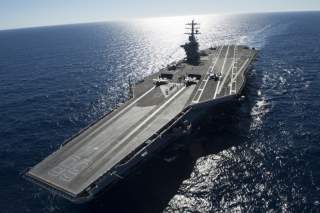America's New Aircraft Carriers Will Use Lasers to Annihilate Missiles
Directed-energy weapons will protect the U.S. Navy's Ford-class carriers.
America’s next-generation aircraft carriers are likely to boast a variety of laser and directed energy weapons, according to U.S. Navy officials.
This week, Military.com, citing a number of senior naval officials, said that the U.S. Navy is exploring the possibility of putting laser weapons onboard the USS Gerald Ford, the lead ship in the Ford-class carrier series.
"The aircraft carrier is a wonderful platform for the installation of directed energy—currently for defensive use and, as technology gets more advanced, you can look at offensive laser technology,” Rear Adm. Michael Manazir, Director of Air Warfare, told Military.com.
According to the report, the USS Gerald Ford is able to generate 13,800 volts of electrical power, over three times as much as Nimitz-class carriers, which can generate 4,160 volts of electricity. Some of this electricity on the USS Gerald Ford will be needed to use the carrier’s state of the art Electro-Magnetic Aircraft Launch System (EMALS), but the rest can be used for things like directed energy weapons and railguns. Furthermore, future Ford-class carriers will likely boast more electrical power.
As Rear Adm. Manazir pointed out, placing laser weapons on aircraft carriers makes a ton of sense. Currently, many fear that aircraft carriers are becoming obsolete as precision-guided anti-ship missiles—most notably, China’s DF-21D anti-ship ballistic missile (ASBM)—proliferate to America’s enemies, who could use them to sink carriers.
The U.S. Navy’s carrier strike groups (CSGs) have considerable air and missile defense firepower, but traditional missile defense systems still suffer from basic arithmetic problems. To begin with, offensive missiles continue to be significantly cheaper to produce and operate than the interceptors used to defend against them. In addition, ships can only carry so many interceptor missiles on board, and the more space given to anti-air and missile defense systems the less offensive firepower they will wield.
Laser and directed energy weapons promise to solve both of these issues. As Manazir explained, “There are finite numbers of missiles and finite installations on the carrier. If you can put a directed energy piece on there with its lower cost per round, you can see where you can start to reduce the cost overall and measurably increase the protection of the ship."
The U.S. Navy already operates a directed energy weapon system; namely, the Laser Weapons System (LaWS), which is onboard the USS Ponce. It is primarily intended to engage threats posed by Iranian unmanned aerial vehicles (UAVs) and small boats that could be used to overwhelm U.S. Navy ships in the Persian Gulf.
Despite the operational capability of the LaWS, directed-energy weapons still have a long way to go toward reaching their potential. A report on the subject published by the Center for a New American Security in April of this year reflected, “Few weapons have held as much promise – and have consistently failed to live up to that promise – as directed-energy weapons.”
The report, which was written by Jason Ellis, further noted:
“After a nearly half-century quest, the U.S. military today is on the cusp of finally fielding operationally relevant directed-energy weapons. While megawatt-class lasers to shoot down ballistic missiles remain, for now, a distant prospect, today’s tactical lasers are potentially useful, cost-effective approaches for countering threats such as low-cost drones and small boats.”
Manazir, the U.S. naval officer, also acknowledged the current limitations of directed-energy weapons, as well as their future promise. “The current technology in directed energy, with the power and cooling required, means that the installations are big and they are heavy – but the technology is rapidly advancing. I’ve seen some concepts that start to get the sizes down.”
Rear Adm. Thomas Moore, Program Executive Officer, Carriers, echoed these thoughts when telling Military.com that: “Lasers need to get up to about 300 kilowatts to start making them effective. The higher the power you get the more you can accomplish. I think there will be a combination of lasers and rail guns in the future. I do think at some point, lasers could replace some existing missile systems. Lasers will provide an overall higher rate of annihilation.”
Zachary Keck is managing editor of The National Interest. You can find him on Twitter: @ZacharyKeck.
Image: Flickr/U.S. Pacific Fleet

